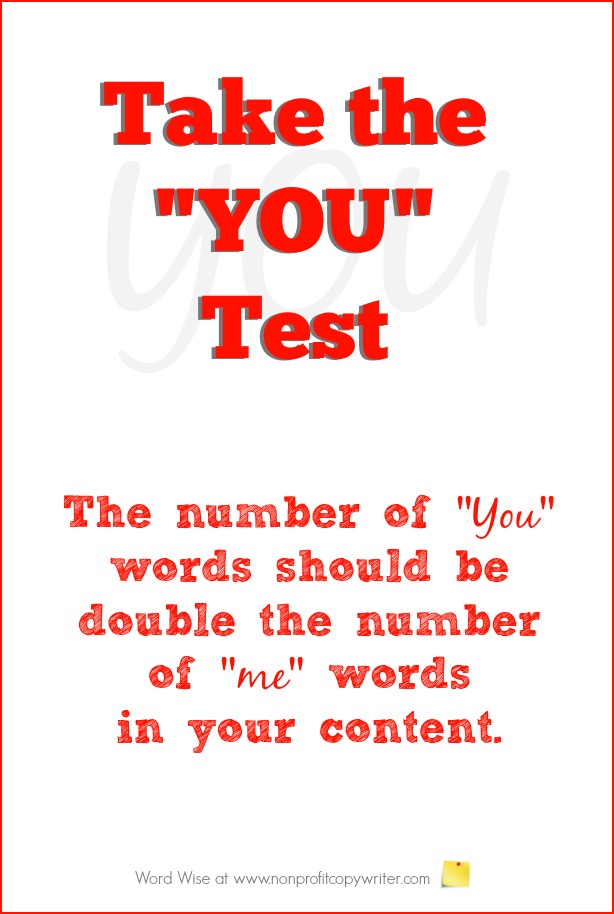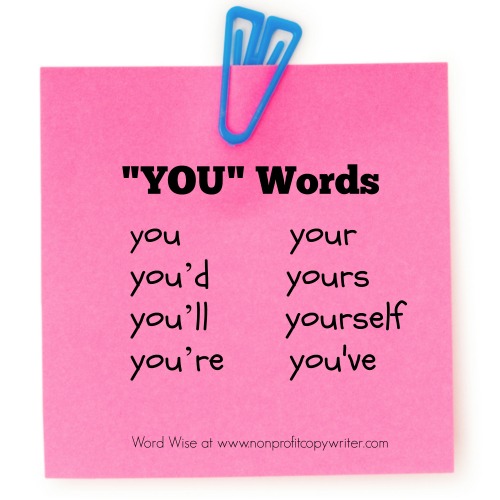Save Time: Get 5 Simple Writing Tips
you can put to use in 10 minutes
Use the "You Test" for More Persuasive Writing
Award-winning writer Kathy Widenhouse has helped hundreds of nonprofits and writers produce successful content , with 750K+ views for her writing tutorials. She is the author of 9 books. See more of Kathy’s content here.
Updated 6.6.24
The “You Test” is an easy and practical self-check you can use for more persuasive writing in your appeal letters, newsletters, web pages, email campaigns, blog posts, response devices, landing pages – pretty much any project.
The test checks your content to see how well it adheres to a top copywriting rule when writing to persuade – the You Rule. Your writing is more persuasive, so the rule goes, when you use “You” words in the text more than “Me” words. (See more about the You Rule here.)
As tests go, this one is super-easy to do – you simply count numbers of You words and Me words (more on that below). It takes just a few minutes and allows you to make upgrades right away.
But first, you probably want to know why you should force yourself to count certain types of words in your beautifully-crafted piece.
Why Take the "You Test"?
You’ve likely had a “friend” who talks a lot about herself. You catch yourself thinking thoughts like this when you’re with her: I cannot get in a word edgewise … I don’t think she cares about me … does she realize that our conversations always center around her?
That’s how your reader feels when you write solely about yourself or your organization.
He senses it when you use more “me” words than “you” words. The word “you” is not just a pronoun. “You” is an emotional trigger that causes the human brain to pay attention.
And naturally, you want your reader to pay attention to what you’re saying. That’s why “you” is crucial in persuasive writing.
What you'll test when you take The You Test
“You” and its variations (you’d, you’ll, you’re, your, yours, yourself, you’ve) act like miniature fly traps, snagging the reader’s thoughts as his eyes skim through your copy. The You word family keeps readers involved. It’s personal. “You” and its variations focus on the reader … what he has done … how her life can be better… what is in it for him … what credit she deserves for helping you in the past … what he will gain from responding to you.
Copy peppered with “you” makes her feel good.
But if your copy is heavy with words from the Me family (I, me, I’m, I’ll, I’ve, my, mine, we, us, we’re, we’ll, our, ours, ourselves), the reader feels excluded. Even though your organization may do amazing work, if the copy talks only about what you do, then your reader feels like an outsider … her needs don’t matter … he hasn’t made a difference for you.
Copy focused on “me” makes her feel badly.
My guess is that you don’t want that for your reader.
So … you take the You Test in order to keep yourself from being a self-centered “friend” in your writing.
How do you take The You Test?
The test is clever copywriting tip credited to donor communications guru Tom Ahern.
To take the You Test, simply count the number of “you” words and the number of “me” words in your piece. “You” words should be at least double the number of “me” words. If the 2-1 ratio minimum is not there, then rewrite until it is.
That’s it.
As for the technical particulars about how to take the test: in Microsoft Word (or other word processing program), select your text and use the “Find” function. First search for “you” variants, highlighting them or changing the font color with red. Then search for “me” variants, highlighting them or changing the color to a color other than red.
Count the words. See what kind of ratio you have. Then …
Make the fixes
To get a 2-to-1 balance (or better) between “you” words and “me” words, replace “me” statements with “you” statements. Rewrite passages that are “you-less.” Then do the test again.
Here’s an example:
Before the Test
We want to help at-risk
kids learn to read and we think you do, too. We believe
that reading is foundational to a better life because it opens the door to
education and job readiness. Our program
helps more underserved kids in Nashville learn to read at or above grade level.
You-Me ratio: 1-4
After the Test
The letter you hold in your hands is not just a collection of lines in
gibberish. Instead, you’re able to understand
what I’m sharing because a teacher or parent
or tutor or friend helped you learn how to read.
What person made that difference for you? For
many kids in Nashville, that person will be you.
You-Me ratio: 6-1
After the test is better, don’t you think?
Take the test, make the changes. and put the focus on someone other than you.
The You Test helps you write persuasively. But even better, it helps you be a good friend.
More About Persuasive Writing
Make The You Rule Work For You ...
Pillars that Persuade: Understand the 3 Persuasive Writing Basics ...
Top 10 Persuasive Copywriting Techniques ...
How to make the "You Rule" work for you ...
Point of view (POV) explained for copywriters and content writers ...
Persuasive techniques 1: one question you MUST answer
Persuasive techniques 2: write to real person ...
Persuasive techniques 3: tell a good story ...
Persuasive techniques 4: give factual proof ...
10 Kinds of Facts That Persuade ...
Persuasive copywriting techniques 5: offer social proof ...
Persuasive Writing Technique 9: Raise (and Refute) Your Reader's Objections ...
5 Basic Objections: How to Raise Them and Refute Them ...
Persuasive writing basics: write to your prospect's needs ...
Simple persuasive writing tip ...
The Power of "Because": persuade by explaining why ...
The Power of "New: It's not a gimmick - it's science ...
How to use repetition to write persuasively ...
More persuasive writing tips on our Pinterest board ...
Return from Use the "You Test" to Nonprofit Copywriter home
As an Amazon Associate I earn from qualifying purchases.
Share This Page

Named to 2022 Writer's Digest list
BEST GENRE/NICHE WRITING WEBSITE


Stop Wasting Time!
Grab your exclusive FREE guide, "5 Simple Writing Tips You Can Put to Use in 10 Minutes or Less"













